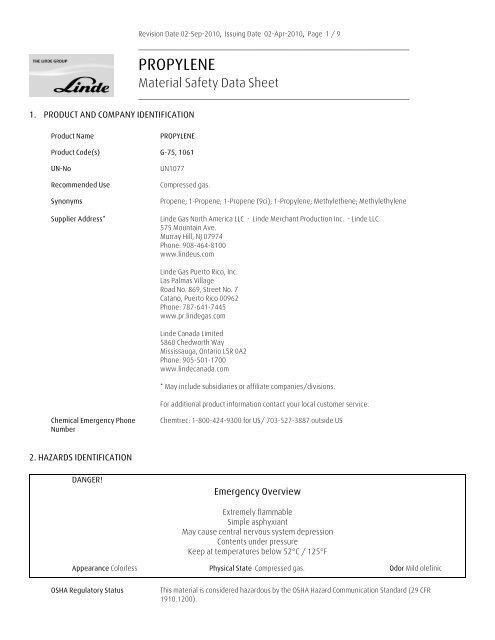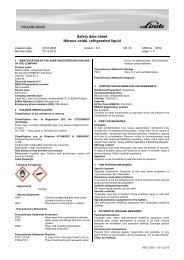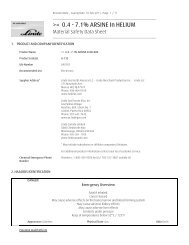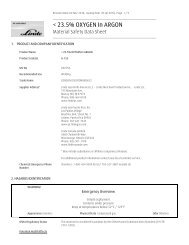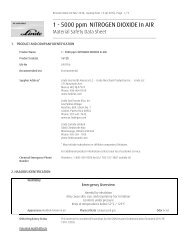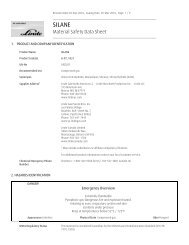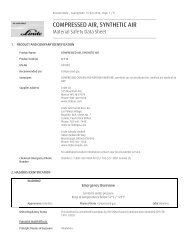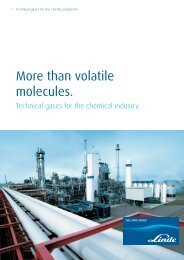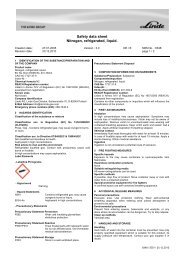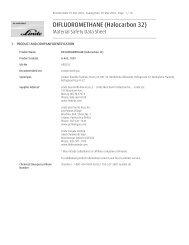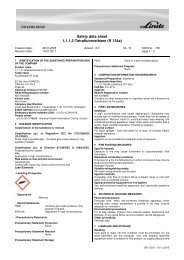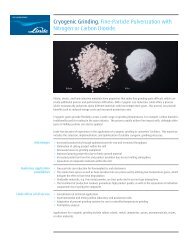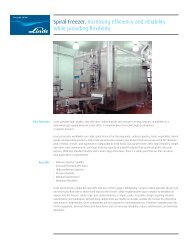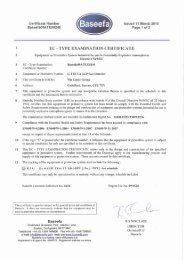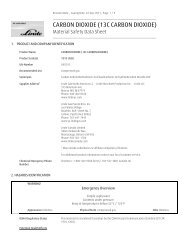PROPYLENE - (MSDS) - Linde Gases
PROPYLENE - (MSDS) - Linde Gases
PROPYLENE - (MSDS) - Linde Gases
Create successful ePaper yourself
Turn your PDF publications into a flip-book with our unique Google optimized e-Paper software.
Revision Date 02-Sep-2010, Issuing Date 02-Apr-2010, Page 1 / 9<br />
_____________________________________________________________________<br />
<strong>PROPYLENE</strong><br />
Material Safety Data Sheet<br />
_____________________________________________________________________<br />
1. PRODUCT AND COMPANY IDENTIFICATION<br />
Product Name<br />
<strong>PROPYLENE</strong><br />
Product Code(s) G-75, 1061<br />
UN-No<br />
Recommended Use<br />
Synonyms<br />
Supplier Address*<br />
UN1077<br />
Compressed gas.<br />
Propene; 1-Propene; 1-Propene (9ci); 1-Propylene; Methylethene; Methylethylene<br />
<strong>Linde</strong> Gas North America LLC - <strong>Linde</strong> Merchant Production Inc. - <strong>Linde</strong> LLC<br />
575 Mountain Ave.<br />
Murray Hill, NJ 07974<br />
Phone: 908-464-8100<br />
www.lindeus.com<br />
<strong>Linde</strong> Gas Puerto Rico, Inc.<br />
Las Palmas Village<br />
Road No. 869, Street No. 7<br />
Catano, Puerto Rico 00962<br />
Phone: 787-641-7445<br />
www.pr.lindegas.com<br />
<strong>Linde</strong> Canada Limited<br />
5860 Chedworth Way<br />
Mississauga, Ontario L5R 0A2<br />
Phone: 905-501-1700<br />
www.lindecanada.com<br />
* May include subsidiaries or affiliate companies/divisions.<br />
For additional product information contact your local customer service.<br />
Chemical Emergency Phone<br />
Number<br />
Chemtrec: 1-800-424-9300 for US/ 703-527-3887 outside US<br />
2. HAZARDS IDENTIFICATION<br />
DANGER!<br />
Emergency Overview<br />
Appearance Colorless<br />
Extremely flammable<br />
Simple asphyxiant<br />
May cause central nervous system depression<br />
Contents under pressure<br />
Keep at temperatures below 52°C / 125°F<br />
Physical State Compressed gas.<br />
Odor Mild olefinic<br />
OSHA Regulatory Status<br />
This material is considered hazardous by the OSHA Hazard Communication Standard (29 CFR<br />
1910.1200).
<strong>PROPYLENE</strong>, Material Safety Data Sheet , Revision Date 02-Sep-2010, Page 2 / 9<br />
___________________________________________________________________<br />
Potential Health Effects<br />
Principle Routes of Exposure<br />
Inhalation.<br />
Acute Toxicity<br />
Inhalation<br />
Eyes<br />
Skin<br />
Skin Absorption Hazard<br />
Ingestion<br />
Chronic Effects<br />
Aggravated Medical<br />
Conditions<br />
Environmental Hazard<br />
Simple asphyxiant. May cause suffocation by displacing the oxygen in the air. Exposure to oxygendeficient<br />
atmosphere (99 C3H6<br />
4. FIRST AID MEASURES<br />
Eye Contact<br />
Skin Contact<br />
Inhalation<br />
Ingestion<br />
Notes to Physician<br />
None required for gas. If frostbite is suspected, flush eyes with cool water for 15 minutes and obtain<br />
immediate medical attention.<br />
In case of contact with liquefied gas, thaw frosted parts with lukewarm water.<br />
PROMPT MEDICAL ATTENTION IS MANDATORY IN ALL CASES OF INHALATION OVEREXPOSURE. RESCUE<br />
PERSONNEL SHOULD BE EQUIPPED WITH SELF-CONTAINED BREATHING APPARATUS. Conscious inhalation<br />
victims should be assisted to an uncontaminated area and inhale fresh air. If breathing is difficult,<br />
administer oxygen. Unconscious persons should be moved to an uncontaminated area and, as<br />
necessary, given artificial resuscitation and supplemental oxygen. Treatment should be symptomatic<br />
and supportive.<br />
None under normal use. Get medical attention if symptoms occur.<br />
Treat symptomatically.<br />
5. FIRE-FIGHTING MEASURES<br />
Flammable Properties<br />
Extremely flammable. Containers may explode when heated.
<strong>PROPYLENE</strong>, Material Safety Data Sheet , Revision Date 02-Sep-2010, Page 3 / 9<br />
___________________________________________________________________<br />
Suitable Extinguishing Media<br />
Hazardous Combustion Products<br />
Dry chemical or CO2. Water spray or fog. DO NOT EXTINGUISH A LEAKING GAS FIRE UNLESS LEAK CAN BE<br />
STOPPED.<br />
Carbon monoxide. Carbon dioxide (CO2).<br />
Explosion Data<br />
Sensitivity to Mechanical Impact<br />
Sensitivity to Static Discharge<br />
Specific Hazards Arising from the<br />
Chemical<br />
Protective Equipment and<br />
Precautions for Firefighters<br />
None<br />
Yes<br />
This product will ignite at ambient temperatures and can be expected to form a flammable mixture<br />
upon release to the atmosphere. May burn with an almost invisible flame in bright light. Continue to<br />
cool fire exposed cylinders until flames are extinguished. Cylinders may rupture under extreme heat.<br />
Damaged cylinders should be handled only by specialists.<br />
If possible, stop the flow of gas. Do not extinguish the fire until supply is shut off as otherwise an<br />
explosive-ignition may occur. If the fire is extinguished and the flow of gas continues, use increased<br />
ventilation to prevent build-up of explosive atmosphere. Ventilation fans must be explosion proof. Use<br />
non-sparking tools to close container valves.<br />
Isolate spill or leak area for at least 100 meters (330 feet) in all directions. Vapors from liquefied gas<br />
are initially heavier than air and spread along ground. Vapors may accumulate in confined areas<br />
(basement, tanks, hopper/tank cars, etc.). Vapors may travel to source of ignition and flash back.<br />
Use water spray to cool surrounding containers. Be cautious of a Boiling Liquid Evaporating Vapor<br />
Explosion, BLEVE, if flame is impinging on surrounding containers.<br />
As in any fire, wear self-contained breathing apparatus pressure-demand, MSHA/NIOSH (approved or<br />
equivalent) and full protective gear.<br />
6. ACCIDENTAL RELEASE MEASURES<br />
Personal Precautions<br />
Environmental Precautions<br />
Methods for Containment<br />
Methods for Cleaning Up<br />
ELIMINATE all ignition sources (no smoking, flares, sparks or flames in immediate area). Evacuate<br />
personnel to safe areas. Keep people away from and upwind of spill/leak. All equipment used when<br />
handling the product must be grounded. Wear self-contained breathing apparatus when entering area<br />
unless atmosphere is proved to be safe. Monitor oxygen level.<br />
Beware of vapors accumulating to form explosive concentrations. Vapors can accumulate in low areas.<br />
Prevent spreading of vapors through sewers, ventilation systems and confined areas.<br />
Stop the flow of gas or remove cylinder to outdoor location if this can be done without risk. If leak is in<br />
container or container valve, contact the appropriate emergency telephone number in Section 1 or call<br />
your closest <strong>Linde</strong> location.<br />
Return cylinder to <strong>Linde</strong> or an authorized distributor.<br />
7. HANDLING AND STORAGE<br />
Handling<br />
Ground and bond all lines and equipment associated with product system. All equipment should be<br />
non-sparking and explosion proof. Remove all sources of ignition. Ensure adequate ventilation. "NO<br />
SMOKING" signs should be posted in storage and use areas.<br />
Never attempt to lift a cylinder by its valve protection cap. Protect cylinders from physical damage; do<br />
not drag, roll, slide or drop. When moving cylinders, even for short distance, use a cart designed to<br />
transport cylinders. Use equipment rated for cylinder pressure. Use backflow preventive device in<br />
piping.
<strong>PROPYLENE</strong>, Material Safety Data Sheet , Revision Date 02-Sep-2010, Page 4 / 9<br />
___________________________________________________________________<br />
Use an adjustable strap wrench to remove over-tight or rusted caps. Never insert an object (e.g.<br />
wrench, screwdriver, pry bar,etc.) into valve cap openings. Doing so may damage valve, causing leak<br />
to occur. If user experiences any difficulty operating cylinder valve discontinue use and contact<br />
supplier.<br />
Never put cylinders into trunks of cars or unventilated areas of passenger vehicles. Never attempt to<br />
refill a compressed gas cylinder without the owner's written consent. Never strike an arc on a<br />
compressed gas cylinder or make a cylinder a part of an electrical circuit.<br />
For additional recommendations consult Compressed Gas Association's (CGA) Safety Bulletin SB-2,<br />
Oxygen-Deficient Atmospheres.<br />
Storage<br />
Outside or detached storage is preferred. Protect from physical damage. Cylinders should be stored<br />
upright with valve protection cap in place and firmly secured to prevent falling. Store in cool, dry, wellventilated<br />
area of non-combustible construction away from heavily trafficked areas and emergency<br />
exits. Keep at temperatures below 52°C / 125°F. Full and empty cylinders should be segregrated. Use a<br />
"first in-first out" inventory system to prevent full cylinders from being stored for excessive periods of<br />
time. Always store and handle compressed gas cylinders in accordance with Compressed Gas<br />
Association, pamphlet CGA-P1, Safe Handling of Compressed <strong>Gases</strong> in Containers.<br />
8. EXPOSURE CONTROLS / PERSONAL PROTECTION<br />
Exposure Guidelines<br />
Chemical Name ACGIH TLV OSHA PEL NIOSH IDLH<br />
Propylene<br />
TWA: 500 ppm<br />
115-07-1<br />
Engineering Measures<br />
Ventilation<br />
Showers. Eyewash stations. Explosion proof ventilation systems. Use spark-proof tools and explosionproof<br />
equipment.<br />
Use ventilation adequate to keep exposures below recommended exposure limits.<br />
Personal Protective Equipment<br />
Eye/Face Protection<br />
Skin and Body Protection<br />
Wear protective eyewear (safety glasses).<br />
Work gloves and safety shoes are recommended when handling cylinders. Cotton or Nomex® clothing<br />
is recommended to prevent static build-up.<br />
Respiratory Protection<br />
General Use<br />
Emergency Use<br />
Hygiene Measures<br />
If exposure limits are exceeded or irritation is experienced, NIOSH/MSHA approved respiratory<br />
protection should be worn. Positive-pressure supplied air respirators may be required for high airborne<br />
contaminant concentrations. Respiratory protection must be provided in accordance with current local<br />
regulations.<br />
Use positive pressure airline respirator with escape cylinder or self contained breathing apparatus for<br />
oxygen-deficient atmospheres (
<strong>PROPYLENE</strong>, Material Safety Data Sheet , Revision Date 02-Sep-2010, Page 5 / 9<br />
___________________________________________________________________<br />
9. PHYSICAL AND CHEMICAL PROPERTIES<br />
Appearance<br />
Colorless.<br />
Odor<br />
Mild olefinic.<br />
Odor Threshold<br />
23 ppm (detection); 68-80 ppm Physical State<br />
Compressed gas<br />
(recognition)<br />
Flash Point -162°F / -108°C Flashpoint Method Tag closed cup<br />
Autoignition Temperature 460°C / 927°F<br />
Decomposition Temperature No information available.<br />
Boiling Point/Range<br />
-47.7°C / -53.9°F<br />
Freezing Point<br />
-185.25°C / -301.5°F<br />
Molecular Weight 42.08<br />
Water Solubility<br />
Slightly soluble<br />
Evaporation Rate<br />
No information available<br />
Vapor Pressure 151 PSIA @ 70°F<br />
Vapor Density 1.43 (air = 1)<br />
VOC Content (%)<br />
Not applicable.<br />
Partition Coefficient (noctanol/water)<br />
Log P oct = 1.77 (measured)<br />
Specific Vol. @ 21.1°C & 1 atm 12.7 ft³/lb (0.793 m³/kg)<br />
Flammability Limits in Air<br />
Upper 11%<br />
Lower<br />
2.1%<br />
10. STABILITY AND REACTIVITY<br />
Stability<br />
Incompatible Products<br />
Conditions to Avoid<br />
Hazardous Decomposition<br />
Products<br />
Hazardous Polymerization<br />
Stable under recommended storage conditions.<br />
Oxidizing agents. Acids. Halogenated compounds. Nitrogen dioxide. Molten sulfur.<br />
Heat, flames and sparks. Reacts with oxides of nitrogen to form an explosive product. May explode at<br />
high temperatures and pressure (955 atm; 327°C).<br />
Carbon monoxide (CO). Carbon dioxide (CO2).<br />
Self polymerization will not occur. Explosive polymerization is initiated by lithium nitrate and sulfur<br />
dioxide.<br />
11. TOXICOLOGICAL INFORMATION<br />
Acute Toxicity<br />
LD50 Oral:<br />
LD50 Dermal:<br />
LC50 Inhalation:<br />
Repeated Dose Toxicity<br />
No information available.<br />
No information available.<br />
658 ppm/4 hr (Rat)<br />
No information available.<br />
Chronic Toxicity<br />
Chronic Toxicity<br />
Carcinogenicity<br />
None known.<br />
Contains no ingredient listed as a carcinogen.<br />
Chemical Name ACGIH IARC NTP OSHA<br />
Propylene Group 3<br />
Irritation<br />
No information available.
<strong>PROPYLENE</strong>, Material Safety Data Sheet , Revision Date 02-Sep-2010, Page 6 / 9<br />
___________________________________________________________________<br />
Sensitization<br />
Reproductive Toxicity<br />
Developmental Toxicity<br />
Synergistic Materials<br />
Target Organ Effects<br />
No information available.<br />
No information available.<br />
Oxygen deficiency during pregnancy has produced developmental abnormalities in humans and<br />
experimental animals.<br />
None known.<br />
None known.<br />
12. ECOLOGICAL INFORMATION<br />
Ecotoxicity<br />
Will not bioconcentrate.<br />
Ozone depletion potential; ODP; (R-11 = 1): Does not contain ozone depleting chemical (40 CFR Part 82).<br />
Chemical Name<br />
Log Pow<br />
Propylene 2.8<br />
13. DISPOSAL CONSIDERATIONS<br />
Waste Disposal Methods<br />
Do not attempt to dispose of residual waste or unused quantities. Return in the shipping container<br />
PROPERLY LABELED WITH ANY VALVE OUTLET PLUGS OR CAPS SECURED AND VALVE PROTECTION CAP IN<br />
PLACE to <strong>Linde</strong> for proper disposal.<br />
14. TRANSPORT INFORMATION<br />
DOT<br />
Proper Shipping Name<br />
Propylene<br />
Hazard Class 2.1<br />
Subsidiary Class<br />
None<br />
UN-No<br />
UN1077<br />
Description<br />
UN1077,Propylene,2.1<br />
Emergency Response Guide Number 115<br />
TDG<br />
Proper Shipping Name<br />
Propylene<br />
Hazard Class 2.1<br />
UN-No<br />
UN1077<br />
Description<br />
UN1077,<strong>PROPYLENE</strong>,2.1<br />
MEX<br />
Proper Shipping Name<br />
Propylene<br />
Hazard Class 2.1<br />
UN-No<br />
UN1077<br />
Description<br />
UN1077, Propylene,2.1
<strong>PROPYLENE</strong>, Material Safety Data Sheet , Revision Date 02-Sep-2010, Page 7 / 9<br />
___________________________________________________________________<br />
IATA<br />
UN-No<br />
UN1077<br />
Proper Shipping Name<br />
Propylene<br />
Hazard Class 2.1<br />
ERG Code<br />
10 L<br />
Description<br />
UN1077,Propylene,2.1<br />
Maximum Quantity for Passenger<br />
Forbidden<br />
Maximum Quantity for Cargo Only<br />
150 kg<br />
Limited Quantity<br />
No information available.<br />
IMDG/IMO<br />
Proper Shipping Name<br />
Propylene<br />
Hazard Class 2.1<br />
UN-No<br />
UN1077<br />
EmS No.<br />
F-D, S-U<br />
Description UN1077, Propylene,2.1, FP -108C<br />
ADR<br />
Proper Shipping Name<br />
Propylene<br />
Hazard Class 2.1<br />
UN-No<br />
UN1077<br />
Classification Code<br />
2F<br />
Description<br />
UN1077, Propylene,2.1,<br />
15. REGULATORY INFORMATION<br />
International Inventories<br />
TSCA<br />
DSL<br />
EINECS/ELINCS<br />
Complies<br />
Complies<br />
Complies<br />
Legend<br />
TSCA - United States Toxic Substances Control Act Section 8(b) Inventory<br />
DSL/NDSL - Canadian Domestic Substances List/Non-Domestic Substances List<br />
EINECS/ELINCS - European Inventory of Existing Commercial Chemical Substances/EU List of Notified Chemical Substances<br />
U.S. Federal Regulations<br />
SARA 313<br />
Section 313 of Title III of the Superfund Amendments and Reauthorization Act of 1986 (SARA). This product contains a chemical or chemicals<br />
which are subject to the reporting requirements of the Act and Title 40 of the Code of Federal Regulations, Part 372:<br />
Chemical Name CAS-No SARA 313 - Threshold Values %<br />
Propylene 115-07-1 1.0<br />
SARA 311/312 Hazard Categories<br />
Acute Health Hazard<br />
Chronic Health Hazard<br />
Fire Hazard<br />
Sudden Release of Pressure Hazard<br />
Reactive Hazard<br />
Yes<br />
No<br />
Yes<br />
Yes<br />
No
<strong>PROPYLENE</strong>, Material Safety Data Sheet , Revision Date 02-Sep-2010, Page 8 / 9<br />
___________________________________________________________________<br />
Clean Water Act<br />
This product does not contain any substances regulated as pollutants pursuant to the Clean Water Act (40 CFR 122.21 and 40 CFR 122.42).<br />
Risk and Process Safety Management Programs<br />
This material, as supplied, contains one or more regulated substances with specified thresholds under 40 CFR Part 68 or regulated as a<br />
highly hazardous chemical pursuant to the 29 CFR Part 1910.110 with specified thresholds:<br />
Chemical Name U.S. - CAA (Clean Air Act) -<br />
Accidental Release Prevention -<br />
Toxic Substances<br />
Propylene<br />
U.S. - CAA (Clean Air Act) -<br />
Accidental Release Prevention -<br />
Flammable Substances<br />
10000 lbs<br />
U.S. - OSHA - Process Safety<br />
Management - Highly Hazardous<br />
Chemicals<br />
Clean Air Act, Section 112 Hazardous Air Pollutants (HAPs) (see 40 CFR 61)<br />
This product does not contain any substances regulated as hazardous air pollutants (HAPS) under Section 112 of the Clean Air Act<br />
Amendments of 1990.<br />
CERCLA/SARA<br />
This material, as supplied, does not contain any substances regulated as hazardous substances under the Comprehensive Environmental<br />
Response Compensation and Liability Act (CERCLA) (40 CFR 302) or the Superfund Amendments and Reauthorization Act (SARA) (40 CFR<br />
355). There may be specific reporting requirements at the local, regional, or state level pertaining to releases of this material.<br />
U.S. State Regulations<br />
California Proposition 65<br />
This product does not contain any Proposition 65 chemicals.<br />
U.S. State Right-to-Know Regulations<br />
Chemical Name Massachusetts New Jersey Pennsylvania Illinois<br />
Rhode Island<br />
Propylene X X X X<br />
International Regulations<br />
Canada<br />
This product has been classified in accordance with the hazard criteria of the Controlled Products Regulations (CPR) and the <strong>MSDS</strong><br />
contains all the information required by the CPR.<br />
WHMIS Hazard Class<br />
A Compressed gases<br />
B1 Flammable gas<br />
Chemical Name<br />
Propylene<br />
NPRI<br />
X<br />
Legend<br />
NPRI - National Pollutant Release Inventory
<strong>PROPYLENE</strong>, Material Safety Data Sheet , Revision Date 02-Sep-2010, Page 9 / 9<br />
___________________________________________________________________<br />
16. OTHER INFORMATION<br />
Prepared By<br />
Issuing Date<br />
Revision Date<br />
Product Stewardship<br />
23 British American Blvd.<br />
Latham, NY 12110<br />
1-800-572-6501<br />
02-Apr-2010<br />
02-Sep-2010<br />
Revision Number 1<br />
Revision Note (M)SDS sections updated. 1.<br />
NFPA Health Hazard 2 Flammability 4 Stability 1 Physical and Chemical<br />
Hazards -<br />
HMIS Health Hazard 1 Flammability 4 Physical Hazard 2 Personal Protection -<br />
Note: Ratings were assigned in accordance with Compressed Gas Association (CGA) guidelines as published in CGA Pamphlet P-19-2009,<br />
CGA Recommended Hazard Ratings for Compressed <strong>Gases</strong>, 3rd Edition.<br />
General Disclaimer<br />
For terms and conditions, including limitation of liability, please refer to the purchase agreement in effect between <strong>Linde</strong> LLC, <strong>Linde</strong> Merchant<br />
Production, Inc. or <strong>Linde</strong> Gas North America LLC (or any of their affiliates and subsidiaries) and the purchaser.<br />
DISCLAIMER OF EXPRESSED AND IMPLIED WARRANTIES<br />
Although reasonable care has been taken in the preparation of this document, we extend no warranties and make no representations as to the accuracy<br />
or completeness of the information contained herein, and assume no responsibility regarding the suitability of this information for the user's intended<br />
purposes or for the consequences of its use. Each individual should make a determination as to the suitability of the information for their particular<br />
purpose(s).<br />
End of Safety Data Sheet


